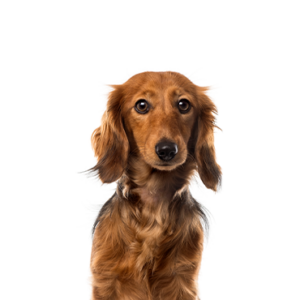Please create a free account below, or login by clicking here.
Petland Racine, Wisconsin

This dog breed originated from Germany and back then they were referred to as the badger dog. In essence, the ‘Dachs’ in Dachshund stands for badger while the ‘hund’ means dog. This dog breed can be traced to the 15th century and they came in different sizes.
However, in the 18th and 19th centuries ‘Teckel’ as called in Germany was refined and elongated. The purpose of this was to create a dog that could fit into the burrows of a badger and lure him out or kill him.
A lot of years went into this development and in the 1800s people started keeping Dachshunds as pets rather than hunting dogs.
Dachshunds like to enter into the spirit of everything you do, which isn’t always the greatest help, especially when you are doing something like tying your shoes. They are playful dogs, but they insist on you following their rules of play, which may or may not coincide with the rules commonly used by their other canine cousins. For example, although they often like to chase balls, they don’t necessarily see the need to bring them back to you. This is an example of a Dachshund rule of play, and is probably related to their curious, but independent nature.
Anyone who meets a Dachshund has no doubt about who’s dog it is. They are often one-person dogs, meaning they bond very closely with their master. A Dachshund’s master is never alone – they have a long, low shadow following them everywhere around the house. This is not to suggest that Dachshunds dislike other humans – quite the contrary, especially if they are well socialized at an early age. But they know which human is theirs.
This petite dog can thrive in an apartment setting. However, they have a low tolerance for cold weather as their fur is thin, but they can handle the heat. Any loving environment where the dachshund will have a good amount of exercise or walks is fine with this breed.
They’re very sensitive breeds and love pleasing its owners. This dog breed is known to develop better in an environment with kids around as they’re very kid-friendly.
Many owners think that because they are so small, Dachshunds don’t require more exercise than just running around the house. However, they do need regular exercise not only to stay fit, but also to build strong muscles to support and protect their back. Two walks every day of moderate length should be sufficient. To avoid injury, never allow your Dachshund to run up and down stairs or jump on or off furniture. Because they are very social, Dachshunds don’t do well as outdoor dogs’¿they want to be with their humans.
Dachshunds are moderate shedders, relatively clean, and have little or no body odor. The breed’s grooming needs vary with the three coat types. Smooth-coated Dachshunds are somewhat ‘wash and wear,” needing little beyond a wipe with a towel or hound glove to look dapper. Longhaired Dachshunds may require more frequent brushing, depending on the thickness of the coat. The Wirehaired coat can be plucked or hand-stripped several times a year to look its best, but beyond that is easy to maintain between groomings with occasional trimming of the beard and eyebrows and brushing or combing once or twice a week. All Dachshunds should have their nails trimmed every month.
There are 176 recognized colors in Dachshunds. Depending on their type they could be red, cream, black, chocolate, gray, fawn, tan, dapple or Pibald.
A dachshund lives for about 12-16 human years.
Dachshunds are hounds.
Miniature Dachshunds are less than 11 pounds, Standards are 16-32 pounds, “Tweenies” are 12-15 pounds.
Dachshunds are very intelligent but are also independent and often stubborn, so they can be a challenge to train. They love to give and receive affection and do best with positive, reward-based training. They are sensitive and will not react well to harsh commands or punishment. Patience and consistence are key. Dachshunds have an excellent sense of smell as well as a strong prey drive. Because they were bred to stay focused and follow a trail without distraction, if they are busy with something more interesting they may not always pay attention to you.
The Dachshund is protective of his environment and may bark when he senses a potential threat or out of the ordinary event.
Generally a healthy breed, the Dachshund can be expected to live 12 to 16 years with proper care, so long as he’s kept on a good diet and has enough exercise to maintain good muscle tone. To prevent disc damage to the Dachshund’s long back, be vigilant about keeping him from becoming overweight, and always monitor his activities to avoid back injury. Like most dogs with drop ears, Dachshunds can get ear infections if their ears aren’t kept clean.
Dachshunds that have been well socialized from a young age are generally fine with strangers. Dachshunds that spend most of their time exclusively with their family are going to be much more wary around new people and you should take those interactions slowly.
Fill out the below form and we'll get back to you as soon as possible. Thanks!
"*" indicates required fields